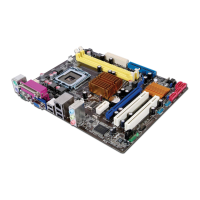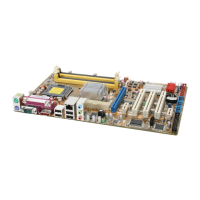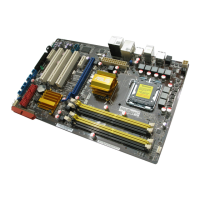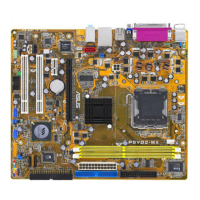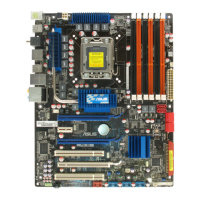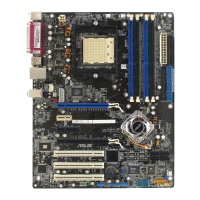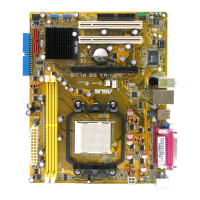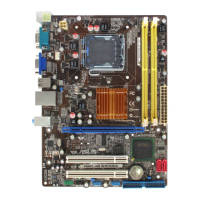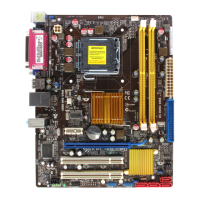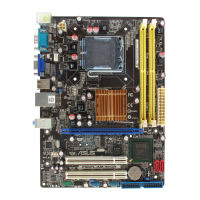
Do you have a question about the Asus P5KPL-AM - SE Motherboard And Intel Core 2 Duo and is the answer not in the manual?
| Model | P5KPL-AM SE |
|---|---|
| CPU Socket Type | LGA 775 |
| Chipset | Intel G31 |
| Memory Type | DDR2 |
| Maximum Memory Supported | 4GB |
| PCI Express x16 Slots | 1 |
| SATA Ports | 4 x SATA 3Gb/s |
| IDE | 1 x ATA100 |
| Audio Chipset | Realtek ALC662 |
| Form Factor | Micro ATX |
| Video Outputs | 1 x VGA |
| Supported CPU | Intel Core 2 Duo / Core 2 Quad / Pentium Dual Core / Celeron |
| Number of Memory Slots | 2 |
| Memory Standard | DDR2 800/667 MHz |
| Expansion Slots | 1 x PCI Express x16, 2 x PCI |
| LAN | 10/100 Mbps |
| USB Ports | 8 x USB 2.0 (4 at back panel, 4 at mid-board) |
| Audio | 6-Channel High Definition Audio |
Precautions to prevent electrical shock during system operation and component handling.
Guidelines for safe installation and operation of the motherboard and its components.
Outlines the structure and content of the user manual.
Lists resources for additional product and software updates.
Explains text formatting conventions like bold, italics, and key notations.
Details CPU, chipset, memory, expansion slots, and rear panel connectors.
Lists internal connectors, BIOS features, accessories, and form factor.
A greeting to the motherboard and a list of included package items.
Highlights key technologies like Green ASUS and Quad-core processor support.
Details ASUS-specific features like Q-Fan, MyLogo, EZ Flash, and CPR.
Important installation precautions and explanation of the onboard LED indicator.
Instructions on orienting and securing the motherboard in the chassis.
A diagram showing the location of connectors and components on the motherboard.
A categorized list of motherboard slots, jumpers, and connectors.
Step-by-step instructions for installing a CPU into the LGA775 socket.
Instructions for mounting the CPU heatsink and fan assembly.
Steps for safely removing the CPU heatsink and fan assembly.
Overview of the motherboard's DDR2 DIMM sockets and memory installation.
Details on compatible memory sizes, limitations, and configuration notes.
Lists compatible DDR2 memory modules from various vendors.
Step-by-step instructions for installing and removing memory modules.
Guide on physically installing and software configuring expansion cards.
Details standard interrupt assignments and IRQ allocation for this motherboard.
Describes PCI, PCI Express x1, and PCI Express x16 slots and their uses.
Instructions for clearing the CMOS using the CLRTC jumper.
Identifies and describes the ports on the motherboard's rear I/O panel.
Describes the various internal headers and connectors on the motherboard.
Overview of utilities for managing and updating the motherboard's BIOS.
Instructions for updating the BIOS using the ASUS EZ Flash 2 utility.
Guide to using the AFUDOS utility for BIOS updates in DOS mode.
Instructions for recovering BIOS from floppy disk using CrashFree BIOS 3.
Guide for using the ASUS Update utility in Windows for BIOS management.
Explains how to enter and navigate the BIOS setup program.
Describes the BIOS menu structure, including menu bar, items, and navigation keys.
Details the options available in the Main BIOS menu for system configuration.
Explains settings for IDE devices, including Master/Slave and drive modes.
Shows detected BIOS, processor, and system memory details.
Settings for system frequency, voltage, and overclocking options.
Details CPU-related settings like ratio adjustment and C1E support.
Advanced chipset settings, including North Bridge and South Bridge configurations.
Settings for onboard LAN, serial, and parallel ports.
Configuration for PCI/PnP devices, IRQ, and DMA assignments.
Settings to select the system suspend state (S1, S3, Auto).
Configuration for ACPI 2.0 and APIC support.
Settings for power-on events like RTC alarm, PCI/PCIe devices, and keyboard/mouse.
Displays system temperatures, fan speeds, and voltages.
Sets the order of devices for system boot-up.
Options for quick boot, screen logo, and error handling during boot.
Options for setting user passwords and password checking.
Access to EZ Flash 2 from the Tools menu for BIOS updates.
Utility to check LAN cable status during POST.
Instructions for saving or discarding configuration changes made in BIOS.
Recommendations for installing compatible operating systems.
Overview of the drivers, applications, and utilities on the support CD.
Details the device drivers available on the support CD for system activation.
Lists the applications and utilities provided on the motherboard support CD.
Provides contact details and support resources for ASUS.
Explains Hyper-Threading Technology and how to enable it in BIOS.
